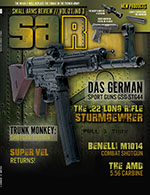Emageeman's Corner: V21N3
By Robert G. Segel
I: Russian silver shooting medal award
The obverse has a central image of an M1910 Maxim machine gun on a wheeled Sokolov mount with engraving above and below the Maxim in Russian that reads, “1st prize for machine gun fire.” The reverse is engraved in Russian (Shamordino 2 base 1919). Shamordino is a small village located on the Seryona River. Measures approximately 1 1/8 x 1 3/8 inches with a suspension loop at the top.
II: Wall plaque for the 2nd Australian Imperial Forces 2nd Machine Gun Battalion.
Red wood shield with insignia of the 2/2 Machine Gun Battalion at the top consisting of the Australian Rising Sun with crossed Vickers machine guns with 2/2nd M.G. BN. Beneath that is the formation patch insignia of a yellow T, bordered in black on a gray T field. At the bottom of the plaque is a banner that reads “2/2 Machine Gun Bn.”
III: World War I German silver presentation cup.
Engraved to the front is the German Iron Cross and “1 Masch. Gew. Komp. Inf. Regt. 372 Weinachten 1915 im Felde” (1st Machine Gun Company, Infantry) Regiment 372, Christmas 1915, in the Field). The bottom of the cup is engraved to “Vicefeldwebel Neumann” (Sergeant 1st Class Neumann). Also on the bottom is the maker marks “H. Nicolai” and imperial era marking for 800 silver. (800 parts of silver per 1,000, or 80% silver, 20% other metal. Sterling silver is 925/1000 or 92.5% silver. (800 silver is not sterling quality.) It was customary in the German army at that time that the regimental commander would present these cups to his NCOs at Christmas time in appreciation of their service. In this instance, this applies to World War I in the field (im Felde) meaning the unit was deployed. The cup is 4 inches tall with a rim diameter of 2 5/16 inches.
IV: Canadian brass shoulder title for the Automobile Machine Gun Brigade.
The letters AMGB are superimposed upon a Colt Automatic Gun Model of 1895/1914. At the start of World War I, Canada, as part of the British Empire Commonwealth, started raising an army to send to France in 1914 in support of England’s war efforts. Among the many groups being raised were armored vehicle units such as Boyles and Eatons Motor Machine Gun Batteries. Vickers machine guns were not available to the Canadians at the start of the war so these raised units bought commercially available Colt Automatic Guns and used them to arm the armored cars. Two lugs to the rear.
V: Lacquered (Urushi) World War II era Imperial Japanese Army commemorative sake cup tray (Obon).
Orange tray bordered in gold with Army star to top with a scattering of white Paulownia leaves (native to China). Centered is an Imperial Japanese Army flag, helmet and fan with an image of a Taisho 3 heavy machine gun. The lettering (kanji) on the helmet translates as “Loyalty and Bravery.” There are two vertical lines of kanji to the left bottom corner above an outline of a cherry blossom. The right vertical column reads, “Commemorating triumphant return from Manchuria and discharge.” The left vertical column reads, “68th Infantry, Mr. Kato.” The kanji inside the cherry blossom reads, “commemorating machine gun unit.” The 68th Infantry Regiment was based in Gifu, near Nagoya and saw service in Manchuria in the 1930s. The tray measures approximately 12 x 8 ¾ inches.
This article first appeared in Small Arms Review V21N3 (April 2017) |
| SUBSCRIBER COMMENT AREA |
Comments have not been generated for this article.








